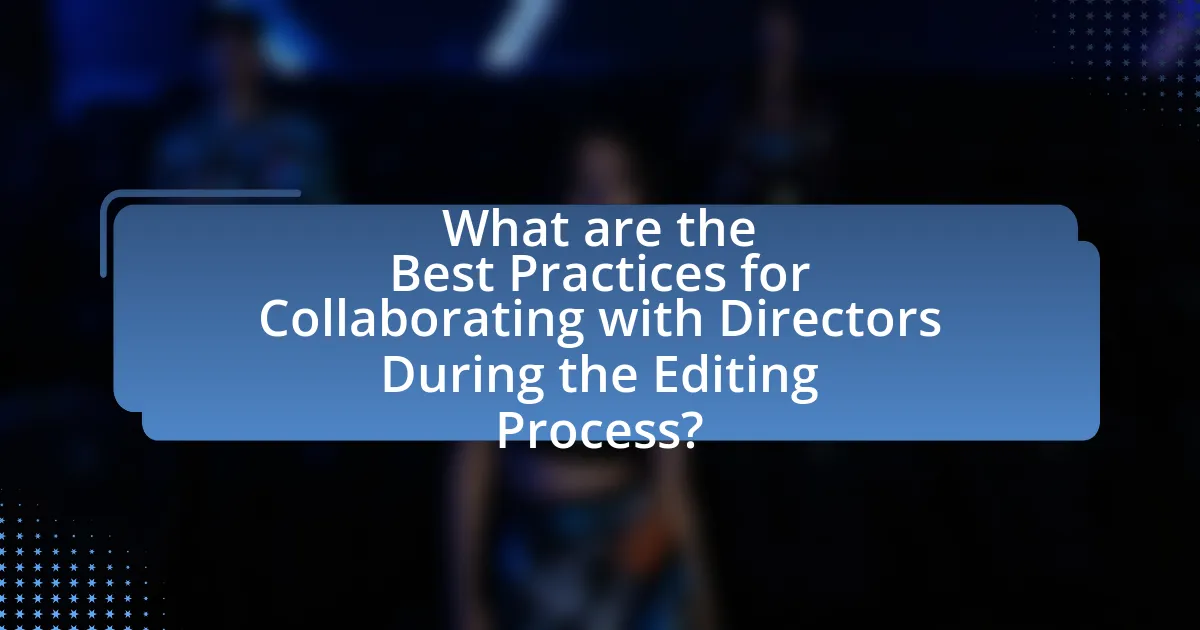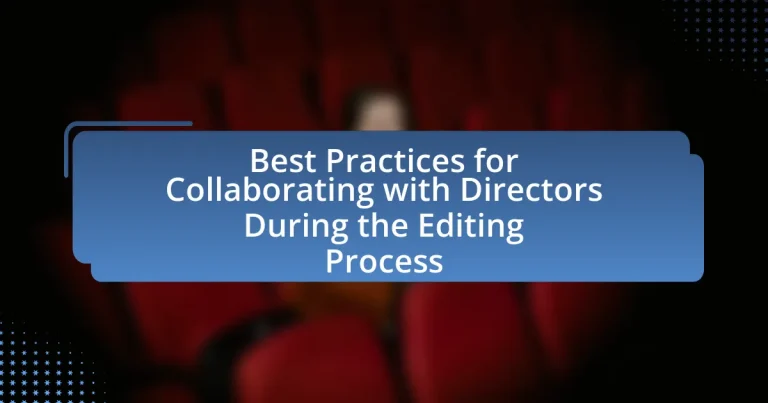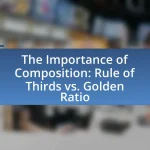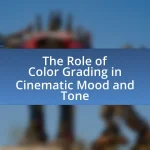The article focuses on best practices for collaborating with directors during the editing process, emphasizing the importance of open communication, understanding the director’s vision, and providing regular updates. It outlines effective communication strategies, including the use of collaborative tools like Slack and Zoom, and highlights the significance of regular check-ins and feedback in enhancing the editing workflow. Additionally, the article discusses techniques for managing creative differences, ensuring alignment with the director’s vision, and incorporating last-minute changes, all aimed at achieving a high-quality final product that meets the director’s expectations.

What are the Best Practices for Collaborating with Directors During the Editing Process?
The best practices for collaborating with directors during the editing process include maintaining open communication, understanding the director’s vision, and providing regular updates on progress. Open communication fosters a collaborative environment where feedback can be exchanged freely, ensuring that the editor aligns with the director’s creative intentions. Understanding the director’s vision involves discussing the narrative and emotional tone of the project, which helps the editor make informed decisions about pacing and scene selection. Providing regular updates keeps the director informed about the editing progress and allows for timely feedback, which can enhance the overall quality of the final product. These practices are supported by industry standards that emphasize collaboration as a key factor in successful film editing.
How can editors effectively communicate with directors throughout the editing process?
Editors can effectively communicate with directors throughout the editing process by establishing clear and consistent channels of communication, such as regular meetings and updates. This approach ensures that both parties are aligned on the vision and direction of the project. For instance, utilizing collaborative software allows editors to share edits and receive real-time feedback, fostering a more interactive dialogue. Additionally, providing directors with rough cuts at various stages enables them to offer input early, which can significantly enhance the final product. Research indicates that projects with structured communication frameworks tend to have higher satisfaction rates among directors, as they feel more involved in the editing process.
What communication tools are most effective for collaboration?
Effective communication tools for collaboration include Slack, Microsoft Teams, and Zoom. These platforms facilitate real-time messaging, video conferencing, and file sharing, which are essential for seamless collaboration during the editing process. For instance, Slack allows for organized discussions through channels, while Microsoft Teams integrates with other Microsoft Office applications, enhancing productivity. Zoom provides high-quality video calls, enabling directors and editors to discuss edits in detail. Research indicates that teams using these tools report increased efficiency and improved project outcomes, highlighting their effectiveness in collaborative environments.
How can regular check-ins enhance the editing process?
Regular check-ins can enhance the editing process by ensuring consistent communication and alignment between the editor and the director. These check-ins facilitate immediate feedback, allowing for timely adjustments to the editing direction, which can lead to a more cohesive final product. Research indicates that projects with regular communication checkpoints are 30% more likely to meet deadlines and achieve desired outcomes, as they reduce misunderstandings and misalignments in vision.
What role does feedback play in the collaboration between editors and directors?
Feedback is essential in the collaboration between editors and directors as it facilitates communication and alignment on the creative vision. This iterative process allows editors to understand the director’s intent and make informed decisions about pacing, tone, and narrative structure. For instance, when a director provides specific feedback on a rough cut, the editor can adjust scenes to better reflect the desired emotional impact, ensuring that the final product aligns with the director’s vision. This dynamic exchange not only enhances the quality of the film but also fosters a collaborative environment where both parties contribute to the storytelling process effectively.
How should editors approach receiving feedback from directors?
Editors should approach receiving feedback from directors with an open mind and a collaborative attitude. This involves actively listening to the director’s insights, asking clarifying questions to fully understand their perspective, and being willing to adapt their editing choices based on the feedback provided. Research indicates that effective communication and a willingness to incorporate feedback can significantly enhance the final product, as collaboration fosters a shared vision and improves the overall quality of the project.
What strategies can be used to provide constructive feedback to directors?
To provide constructive feedback to directors, utilize specific, actionable observations that focus on both strengths and areas for improvement. This approach ensures that feedback is balanced and encourages growth. For instance, instead of saying “the pacing is off,” specify “the second act feels slow; consider tightening the dialogue in scenes three and four to enhance momentum.” Research indicates that feedback framed in a constructive manner increases receptiveness and leads to better outcomes, as highlighted in studies on effective communication in creative industries.
Why is understanding the director’s vision crucial during editing?
Understanding the director’s vision is crucial during editing because it ensures that the final product aligns with the intended narrative and emotional impact of the film. The director’s vision serves as a guiding framework that informs editing choices, pacing, and the overall storytelling approach. When editors grasp this vision, they can make informed decisions about which scenes to emphasize, how to structure the narrative, and what tone to convey, ultimately enhancing the coherence and effectiveness of the film. This alignment is supported by the fact that successful films often reflect a strong collaboration between directors and editors, as seen in critically acclaimed works where the editing style complements the director’s artistic intent.
How can editors align their editing style with the director’s vision?
Editors can align their editing style with the director’s vision by actively engaging in communication and collaboration throughout the editing process. This involves understanding the director’s creative intentions, themes, and emotional tone for the project, which can be achieved through discussions, reviewing reference materials, and analyzing the director’s previous works. By incorporating feedback from the director and being adaptable to their preferences, editors can ensure that their editing choices—such as pacing, transitions, and visual style—reflect the director’s artistic goals. This collaborative approach is supported by the fact that successful films often result from strong partnerships between directors and editors, as seen in numerous award-winning projects where the editing style closely mirrors the director’s vision.
What techniques can be used to clarify the director’s vision before editing begins?
To clarify the director’s vision before editing begins, techniques such as detailed pre-production meetings, visual references, and shot lists can be employed. Pre-production meetings allow the director to articulate their vision and expectations clearly, ensuring that all team members are aligned. Visual references, including mood boards or example films, help convey the desired tone and style, providing a concrete framework for the editing process. Additionally, creating shot lists enables the director to specify which scenes and takes are crucial, guiding the editor in prioritizing content that aligns with the director’s intent. These methods collectively enhance communication and understanding, leading to a more cohesive editing phase.
How can editors manage creative differences with directors?
Editors can manage creative differences with directors by fostering open communication and establishing a collaborative environment. This involves actively listening to the director’s vision while articulating the editor’s perspective on how to achieve the desired outcome. Research indicates that successful collaboration often hinges on mutual respect and understanding, which can be facilitated through regular meetings and feedback sessions. For instance, a study published in the Journal of Media Practice highlights that projects with clear communication protocols tend to resolve conflicts more effectively, leading to a more cohesive final product.
What are effective conflict resolution strategies during the editing process?
Effective conflict resolution strategies during the editing process include open communication, active listening, and compromise. Open communication allows all parties to express their viewpoints clearly, which helps in identifying the root cause of the conflict. Active listening ensures that each participant feels heard and understood, fostering a collaborative environment. Compromise involves finding a middle ground where both the editor and the director can agree on changes that satisfy both parties’ creative visions. Research indicates that teams that engage in these strategies are more likely to produce high-quality outcomes, as they minimize misunderstandings and enhance collaboration.
How can editors maintain a positive working relationship despite disagreements?
Editors can maintain a positive working relationship despite disagreements by prioritizing open communication and mutual respect. When editors engage in transparent discussions about differing viewpoints, they create an environment where each party feels valued and heard. This approach fosters collaboration and reduces tension, as evidenced by studies showing that teams with effective communication experience 25% higher productivity. Additionally, actively seeking compromise and focusing on shared goals can help editors and directors navigate conflicts constructively, ensuring that the final product aligns with their collective vision.
What are the key elements of a successful editing workflow with directors?
The key elements of a successful editing workflow with directors include clear communication, collaborative decision-making, and structured feedback processes. Clear communication ensures that both the editor and the director understand the vision and objectives of the project, which is essential for aligning their creative efforts. Collaborative decision-making allows for the integration of the director’s artistic vision with the editor’s technical expertise, fostering a productive partnership. Structured feedback processes, such as scheduled review sessions and organized notes, facilitate efficient revisions and help maintain focus on the project’s goals. These elements are supported by industry practices that emphasize the importance of teamwork and iterative refinement in the editing process.
How can editors establish a clear timeline for the editing process?
Editors can establish a clear timeline for the editing process by creating a detailed schedule that outlines each phase of editing, including deadlines for drafts, feedback, and final revisions. This schedule should be developed collaboratively with directors to ensure alignment on expectations and deliverables. By utilizing project management tools, editors can track progress and adjust timelines as necessary, ensuring that all parties are informed of any changes. Research indicates that structured timelines improve communication and efficiency, leading to a more streamlined editing process.
What tools can streamline the editing workflow between editors and directors?
Collaboration tools such as Frame.io, Adobe Premiere Pro, and Avid Media Composer can streamline the editing workflow between editors and directors. Frame.io offers real-time feedback and version control, allowing directors to comment directly on the footage, which enhances communication and reduces misunderstandings. Adobe Premiere Pro integrates with various plugins that facilitate collaborative editing, enabling seamless sharing of projects and assets. Avid Media Composer provides robust project management features that help track changes and maintain organization throughout the editing process. These tools collectively improve efficiency and clarity in the collaboration between editors and directors.
How can editors ensure that the final product meets the director’s expectations?
Editors can ensure that the final product meets the director’s expectations by maintaining clear communication throughout the editing process. This involves regular check-ins with the director to discuss their vision, preferences, and any specific elements they want to emphasize or alter. Additionally, editors should create rough cuts and seek feedback at various stages, allowing the director to provide input and adjustments before finalizing the edit. This iterative process not only aligns the editor’s work with the director’s vision but also fosters a collaborative environment that can lead to a more polished final product.
What steps should be taken during the final review process?
During the final review process, the primary steps include conducting a thorough content evaluation, ensuring technical accuracy, and obtaining stakeholder feedback. The content evaluation involves reviewing the narrative structure, pacing, and overall coherence to align with the director’s vision. Technical accuracy requires checking for visual and audio quality, ensuring that all elements meet industry standards. Stakeholder feedback is crucial; it involves gathering insights from directors, producers, and other key personnel to make necessary adjustments. These steps are essential to ensure the final product meets both creative and technical expectations, ultimately leading to a polished and professional outcome.
How can editors incorporate last-minute changes effectively?
Editors can incorporate last-minute changes effectively by establishing a clear communication channel with directors and utilizing efficient editing software. Clear communication ensures that editors understand the specific changes required and the rationale behind them, which facilitates quicker implementation. Efficient editing software allows for rapid adjustments, enabling editors to make changes without compromising the overall quality of the project. For instance, tools like Adobe Premiere Pro or Avid Media Composer offer features that streamline the editing process, allowing for quick revisions and real-time collaboration. This approach minimizes disruptions and maintains the project’s timeline, ensuring that last-minute changes are integrated smoothly.
What practical tips can enhance collaboration with directors during editing?
To enhance collaboration with directors during editing, maintain open communication throughout the process. Regular check-ins and updates ensure that both the editor and director are aligned on the vision and progress of the project. Establishing a shared language for discussing edits can also facilitate clearer feedback, allowing for more efficient decision-making. Utilizing collaborative tools, such as shared editing software, enables real-time feedback and adjustments, fostering a more interactive editing environment. Additionally, being receptive to the director’s creative input while providing professional insights can create a balanced partnership that respects both the director’s vision and the editor’s expertise.


